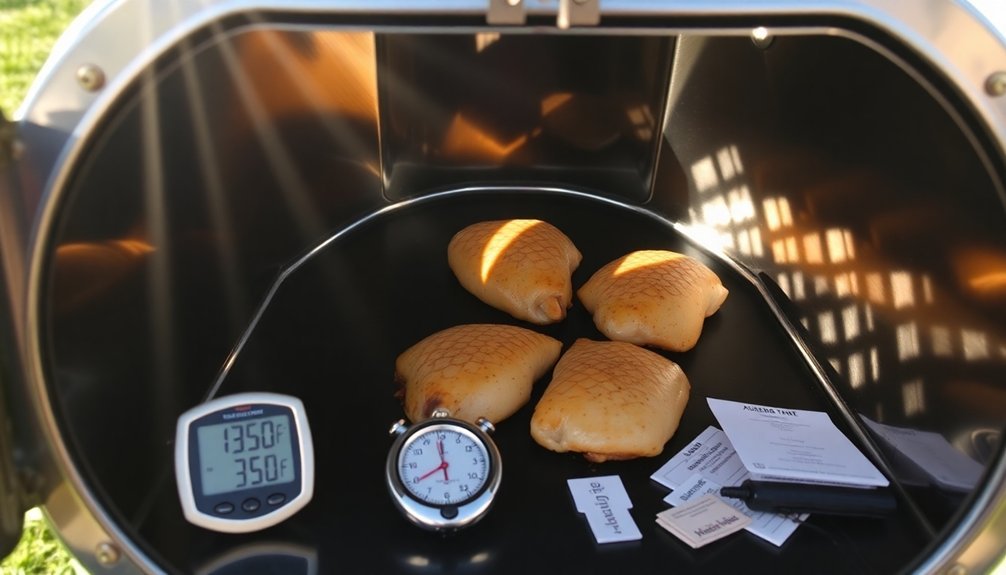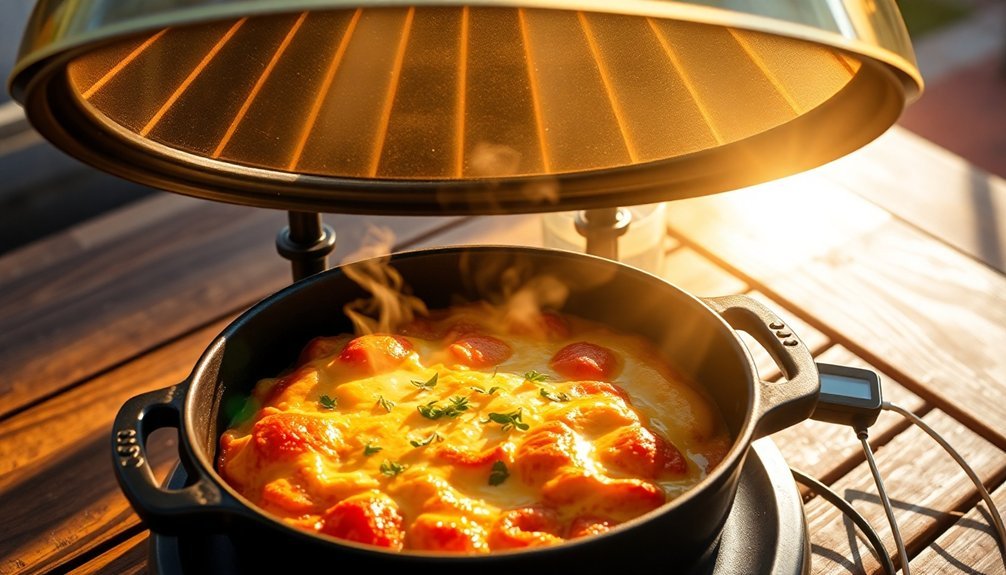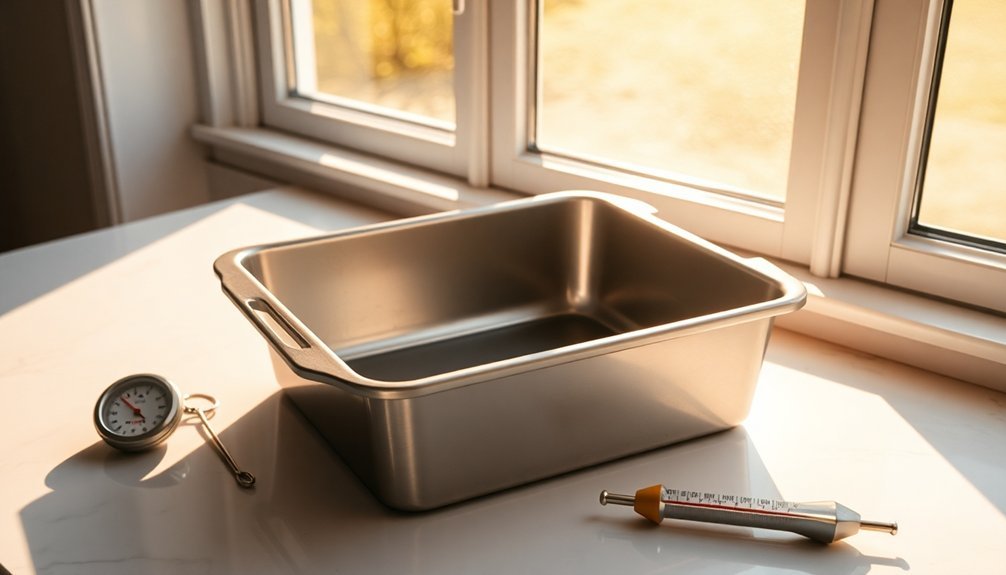For best sun oven cooking, you'll get the best results between 11 AM and 2 PM when sunlight is strongest. You can expect rice to cook in 30-35 minutes at 300°F, while a thawed whole chicken takes 90-120 minutes at 350°F. Dal Bhat needs about 8 hours at 325-350°F, and baked potatoes require 4 hours at 250-300°F. Plan to cook breads and pastries between 10 AM and 2 PM for excellent results. Always preheat your oven 10-15 minutes before cooking, and rotate it every 30-45 minutes to maintain temperatures of 300-375°F. These basic timings are just the beginning of mastering your solar cooking journey.
Prime Solar Cooking Hours

Three key hours define peak solar cooking time: 11 AM to 2 PM. During this window, you'll get the most intense sunlight as the sun moves directly overhead, making your solar cooking most effective.
While you can cook throughout the day, focusing your main meal prep during these prime hours will give you the best results. Using thermal storage methods can help continue cooking even when the sun's intensity drops.
You'll find that in summer months, you can extend your cooking window from 10 AM to 4 PM, giving you more flexibility for meal planning.
However, don't attempt solar cooking early in the morning or after sunset – your oven simply won't work.
For ideal timing, plan to start your meal prep before the peak hours, letting the food cook during the strongest sunlight. Pre-heating your oven before adding food will help guarantee safe cooking temperatures quickly.
Temperature Management For Slow Cooking
Managing temperature in your Sun Oven requires careful attention to both setup and monitoring throughout the cooking process.
You'll need to maintain temperatures above 180°F for effective cooking, with ideal ranges between 150-225°F for most dishes.
To achieve consistent temperatures, you'll want to align your oven with the sun every 30-45 minutes, which can help reach and maintain 300-375°F on clear days. The Sun Oven can reach 400°F maximum temperatures in optimal conditions.
Use dark cookware and verify your reflectors are clean and properly adjusted to maximize heat collection.
Don't forget to monitor your food with a thermometer.
For better heat retention, wrap your cooking cavity with multiple layers of insulation like crumpled newspaper or dry leaves.
Add aluminum foil to enhance reflectivity, and check that your glass door is properly sealed to prevent heat escape.
Seasonal Cooking Time Adjustments

Your sun oven's performance changes dramatically with the seasons, requiring you to adjust your cooking schedule throughout the year.
During peak summer months, you'll enjoy efficient cooking between 11 AM and 3 PM, while winter's shorter days and lower sun angles mean you'll need to start earlier and cook longer.
Spring and fall cooking times fall between these extremes, but you'll need more frequent solar tracking adjustments during these shifting seasons. With proper positioning, your Sun Oven can reach up to 300 degrees with good sun exposure.
Peak Season Cook Times
Understanding peak season cook times helps you maximize your sun oven's efficiency during perfect daylight hours.
You'll get the best results between 10:00 a.m. and 2:00 p.m. when the sun's intensity peaks, allowing you to prepare both lunch and dinner meals.
Position your oven toward the sun's anticipated location at noon or early afternoon. For lunch preparation, face the front panel easterly; for evening meals, orient it westerly.
You'll need to refocus the oven every 30 minutes to maintain ideal temperature.
During peak hours, you can cook a whole chicken in 90-120 minutes at temperatures up to 350°F.
Frozen chickens take longer, requiring about 8 hours starting at 8:00 a.m. Beef or pork roasts under four pounds cook similarly to chicken.
Shorter Winter Day Adjustments
As winter days grow shorter, successful sun oven cooking requires significant adjustments to both timing and positioning.
You'll need to focus your cooking between 10:00 AM and 3:00 PM when the sun's intensity is strongest. Position your oven carefully using the T-leg to capture maximum sunlight, and in higher latitudes, you might need to lay it on its back.
To maintain temperatures between 300-350°F, you'll need to track the sun more frequently and use heat-retaining cookware like Dutch ovens.
Consider using booster panels to enhance cooking efficiency. Plan your meals strategically by preheating early and preparing ingredients in advance.
For larger meals, you may need to cook in stages over multiple days to guarantee food safety and thorough cooking during these limited daylight hours.
Equinox Efficiency Tips
The equinoxes present unique opportunities for sun oven cooking with their balanced daylight hours. You'll find consistent temperatures between 300-350°F during these periods if you properly align your oven with the sun's position above the equator.
To maximize your cooking efficiency during equinoxes, position your oven so its shadow falls directly behind it. For lunch preparation, face the shorter panel easterly; for dinner, orient it westerly.
You'll need to realign your oven every couple of hours to maintain ideal exposure. Use dark pots with tight-fitting lids inside clear, heat-resistant plastic bags to trap heat effectively. Add booster panels to concentrate sunlight and speed up cooking times.
Remember to place your oven on a dry, level surface away from any potential shadows.
Rice And Grain Cook Times
Successful solar cooking of rice and grains depends on proper timing and preparation techniques.
You'll want to start cooking by 9:00 AM for lunch or 1:00 PM for dinner to guarantee your meals are ready on time.
For white rice, combine 1½ cups of basmati rice with 3 cups of boiling water and salt.
You'll need about 30-35 minutes of cooking time in your Sun Oven.
When cooking lentils with rice, start with the lentils first for 30-40 minutes until tender, then add your rice for an additional 45 minutes.
Remember that cooking times vary based on sunlight intensity, ambient temperature, and wind conditions.
You won't need to stir or monitor constantly – just make sure your solar cooker stays oriented toward the sun during peak hours between 10:00 AM and 2:00 PM.
Meat And Protein Cooking Duration

Moving from grains to proteins, cooking meat in your Sun Oven requires careful attention to timing and temperature control.
You'll need to plan ahead, as cooking times vary greatly between thawed and frozen meats. For thawed meats, you can cook a whole chicken in 90-120 minutes at 350°F, while a 2½-pound beef roast takes about 80 minutes.
If you're starting with frozen chicken, plan for an all-day cooking process from 8 AM to 4 PM.
When cooking meat, always use a covered pot or Dutch oven to retain moisture and heat. Keep your Sun Oven aligned with the sun, especially during peak hours (10 AM – 2 PM).
Remember to check that your meat reaches a safe internal temperature of at least 165°F before serving.
Baking Times For Common Foods
Your sun oven can bake a loaf of bread in about 45-50 minutes at 350°F on bright sunny days, while colder weather requires lower temperatures between 250-300°F.
You'll get the best baking results between 10am and 2pm when the sun is strongest, allowing you to maintain steady temperatures for consistent results.
To guarantee even baking and proper temperature control, use smaller containers like mini-muffin tins, check the built-in temperature gauge regularly, and realign your oven with the sun every 30 minutes.
Basic Bread Cook Times
Baking bread in a Sun Oven requires careful attention to timing and temperature management.
You'll need to preheat your oven and align it with the sun while preparing your dough. For a single loaf, expect 45-50 minutes of baking time at 300-350°F, while two loaves will take about 1 to 1.1 hours.
On partly cloudy days, your baking time could stretch to 1.5 hours or more.
You'll want to let your dough rise until it's ½" to ¾" below the pan's rim, then spray it with water before baking to achieve a golden-brown crust.
While your Sun Oven can operate at temperatures as low as 225°F, you'll need longer baking times at these lower temperatures.
Remember to check your bread periodically, as solar temperatures can fluctuate throughout the baking process.
Peak Hour Baking Tips
When planning your solar cooking schedule, understanding peak hours is vital for best results. You'll get optimal baking performance between 11:00 AM and 3:00 PM when the sun is directly overhead.
Start preheating your solar oven by 10:00 AM to guarantee proper temperatures for browning and baking.
For breads, cakes, and pastries, aim to bake between 10:00 AM and 2:00 PM. Use smaller containers for even baking results, especially with items like muffins and cookies.
Keep rotating your oven to track the sun's movement – proper alignment is important when the shadow falls directly behind the cooker. During winter months, you'll need more frequent adjustments due to shorter daylight hours.
Always use dark cookware to maximize heat absorption, and cover your food with a transparent lid to trap heat effectively.
Temperature Control Guidelines
Successful solar cooking depends heavily on maintaining proper temperatures throughout the process. You'll need to monitor temps between 200-300°F (93-149°C) using a reliable digital probe thermometer for safe cooking.
For common foods, you'll find baked potatoes take about 4 hours at 250-300°F, while corn on the cob cooks in just 1 hour at 250°F with husks intact. Your chocolate cake will need around 35 minutes, similar to conventional oven timing. A 2 1/2 pound roast requires 1 hour and 20 minutes, while frozen chicken slow cooks throughout the day.
Remember to preheat your solar oven above 140°F before adding food, and verify meats reach safe internal temperatures: 145°F for whole cuts, 160°F for ground meats, and 165°F for poultry.
Dal Bhat Solar Recipe Times

The traditional Nepali dish Dal Bhat requires careful timing when cooked in a Sun Oven, with three key factors affecting its preparation time: seasonal sun intensity, pot thickness, and alignment frequency.
You'll need to start by preheating your Sun Oven for 10-15 minutes, then stack your dal and rice pots with the rice on top. For best results, cook between 10 a.m. and 2 p.m. when the sun's strongest. The total cooking time is typically 8 hours at 325-350°F.
To speed up cooking, realign your oven every 30 minutes. You can reduce preparation time by pre-soaking your lentils for 8 hours and pre-heating the dal.
Frequently Asked Questions
Can You Cook Frozen Food Directly in a Sun Oven?
Yes, you can cook frozen food directly in your sun oven. You'll need to place it in dark cookware, preheat the oven for 30 minutes, and guarantee regular realignment with the sun for proper cooking.
How Do Clouds Affect Cooking Times During Meal Preparation?
When you're cooking with clouds overhead, you'll need to double or triple your cooking times. You'll also want to realign your sun oven more frequently and monitor temperatures closely for successful meal preparation.
Does Altitude Impact the Effectiveness and Timing of Solar Cooking?
Yes, altitude greatly impacts your solar cooking. You'll need longer cooking times and more liquid since water boils at lower temperatures. For every 1,000 feet above sea level, add 5% to your cooking time.
What Happens if You Forget to Realign the Oven Mid-Cooking?
If you forget to realign your solar oven, your cooking time will increase considerably, and temperatures will drop. You'll risk uneven cooking and potentially unsafe food due to inconsistent heat exposure throughout the process.
Can Multiple Sun Ovens Be Used Simultaneously to Cook Larger Quantities?
Yes, you can use multiple sun ovens together to cook larger quantities. You'll need enough space and sunlight for each oven, but it's a great way to prepare different dishes simultaneously.
In Summary
To get the most from your sun oven, you'll need to master timing and temperature control. Remember to start your meals during peak sunlight hours (10 AM – 2 PM), adjust cooking times seasonally, and always use a food thermometer for meats. With practice, you'll confidently prepare everything from quick-cooking rice to slow-cooked stews. Keep experimenting and recording your results for the best solar cooking success.





Leave a Reply